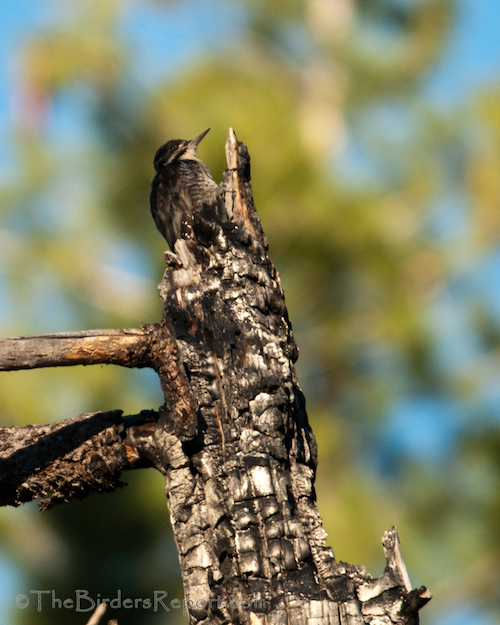 Black-backed Woodpecker (Picoides arcticus) Male photos by Larry Jordan
Black-backed Woodpecker (Picoides arcticus) Male photos by Larry Jordan
I arrived at Lassen Volcanic National Park around 7:00 a.m. It was a cool 48 degrees. I had taken the short drive to the park to search for a family of American Dippers sighted near the visitor center by a fellow birder a few days before. What I found was more than I could possibly hope for.
I parked where I nearly always begin my day at Lassen Park, at the first turn out about 100 yards beyond the northern park entrance ranger station off highway 44. As I got out of my car, about fifty feet from Manzanita Lake, I heard the loud drumming of a woodpecker. Click on photos for full sized images.
I didn’t know what species of woodpecker it was, but I knew it was just in the clearing on the other side of the road. I grabbed my bins, camera and camcorder and headed toward the hollow drumbeat. If not for the drumming, I would probably not have seen the Black-backed Woodpecker (Picoides arcticus), listed by authors of some field guides as “scarce,” by others as “uncommon to rare.”
Note how well camouflaged this bird is atop a snag in its natural habitat of burned coniferous forest.
I approached carefully as I listened to the ever growing sound of the drumming, not wanting to flush a bird I had only seen once before.
Black-backed Woodpeckers are non-migratory, although there have been documented intermittent irruptions of the species outside their normal range. Some of these irruptions have been attributed to a lack of wood-boring insect prey on their normal range or to overpopulation following an insect outbreak1.
Either way, they are usually due to exploitation of wood-boring beetle larvae, their primary food. Range map courtesy of South Dakota Birds and Birding.
The Black-backed Woodpecker and its cousin the Three-toed Woodpecker are the only North American land birds with three toes instead of the usual four.
Since their primary food is wood-boring insect larvae, these woodpeckers have adapted skulls that are highly adapted for pounding, as you probably noticed in the video 😉
Drumming is used by woodpeckers to attract a mate or declare a territory. Since drumming is normally used to communicate over long distances, woodpeckers use surfaces with good acoustic properties like hollow branches or trunks to pound on.
Both the male and female Black-backed Woodpecker drum, and most frequently in the Spring, to attract a mate.
I’m not sure why this guy was drumming but as you saw in the video, he would drum and then appear to be listening for a return signal?
Apparently it is also common for Black-backed Woodpeckers to stretch and preen between drumming episodes.
Whenever I visit Lassen Volcanic National Park, I always search for nesting woodpeckers. A few years ago my friend Jim Arnold photographed a nesting Black-backed Woodpecker in the park at Hat Lake. You can see his excellent photo of the nestling here.
Stay tuned for photos of the American Dippers (or Water Ouzels as I like to call them) and the Brown Creepers I saw later that day in upcoming posts.
If you want to see more great bird photos from around the world, check out World Bird Wednesday!
References: 1Birds of North America Online


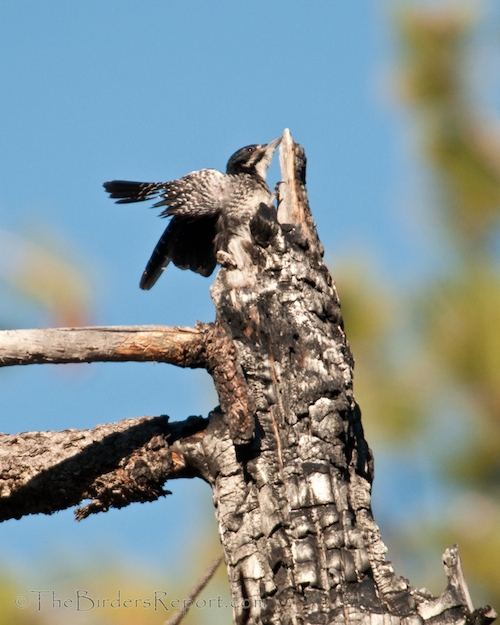
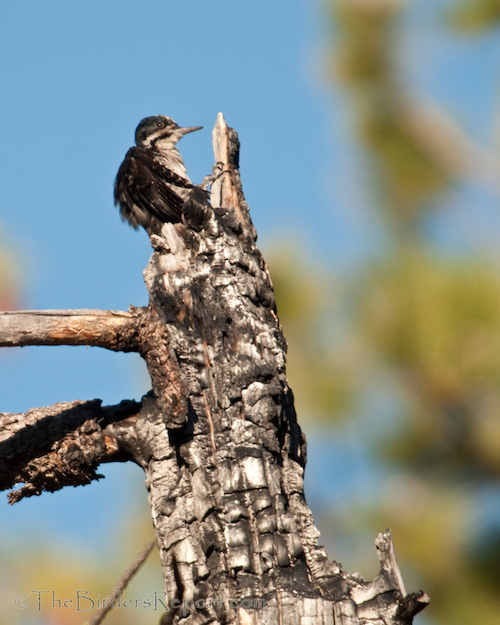
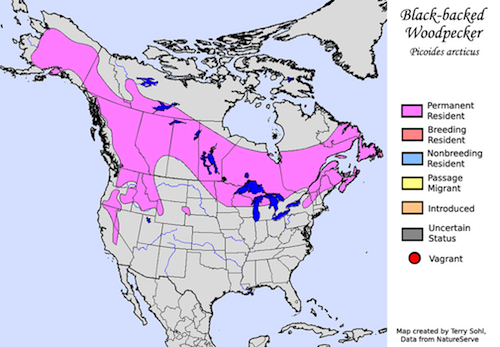
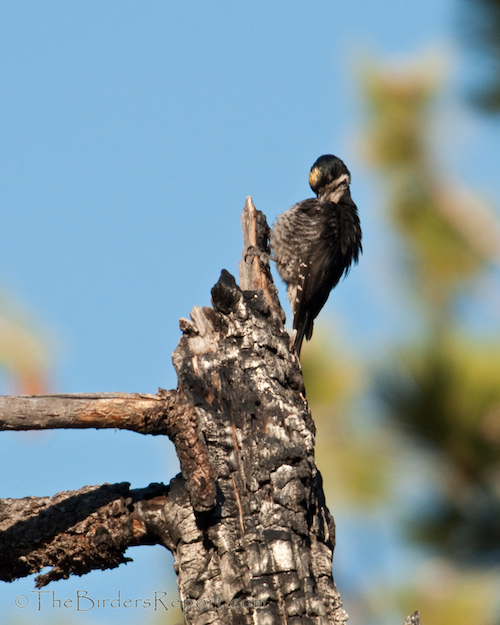
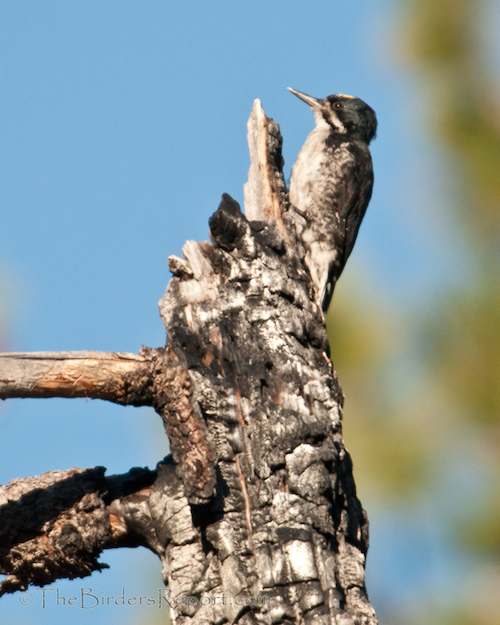
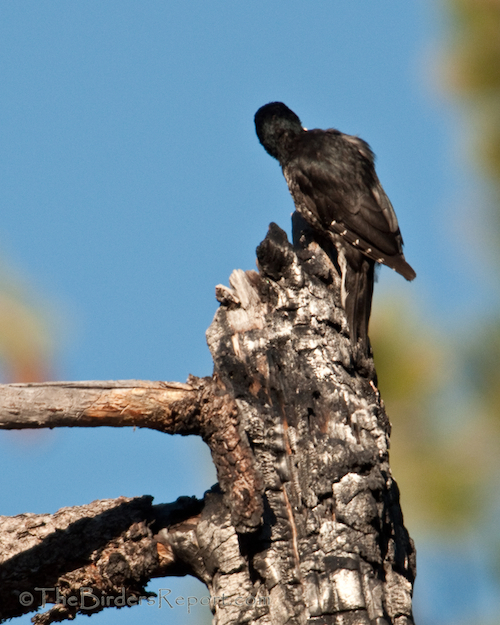
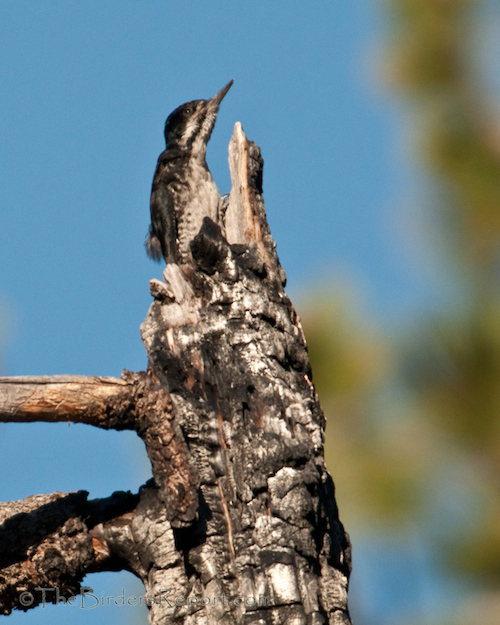
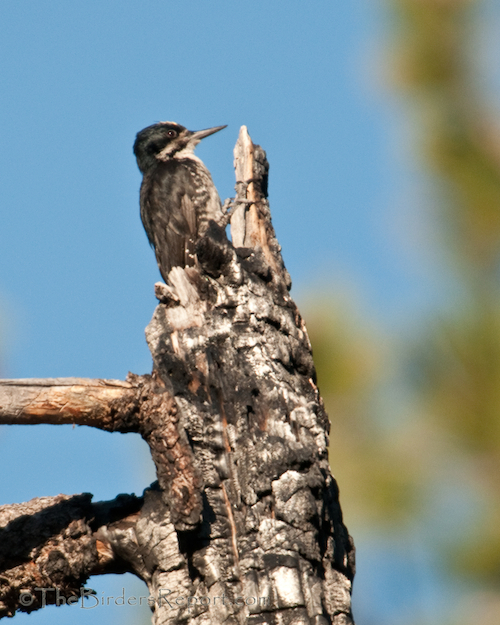








Comments on this entry are closed.
It’s always great to find a bird in an unexpected place and a rare one like this is very special. Great photos.
Excellent photos and especially video! This bird has been a bit of a nemesis for me and I’m still waiting to see one. I am back in Idaho now, so my chances have increased. Just got to make a trip up to a formerly burned out forest.
Great pictures you show. Wishing you a good day 🙂
Wonderful sighting; how special! You must’ve been as happy as ….well, Larry, shall we say? 🙂 Shame I couldn’t view the video, I’ve got an error “the Adobe flash plug-in has crashed ..” Got to sort that one out somehow. Lovely series …
Great post and shots, Larry! This woodie almost blends in with the colors of the tree. Thanks for sharing, it would be a new bird for me. Have a great day.
Great reading! Perfect post for WBW!
I do like the video!
You left me speechless….what an amazing post. And such a thrill to be able to capture such glorious images of this special bird!!!!
Wood Stork
What a wonderful sighting! He certainly blends right in to his surroundings. Your photos and the video are wonderful to see.
Great captures, and they so illusive normally. Boom & Gary of the Vermilon River, Canada.
Another super and informative post Larry. Thanks for sharing this rare species.
A great post. Nice to see the Black-backed woodpecker. Not a bird I’ve seen but hopefully I will one day.
Wonderful video, great stills and excellent information Larry. it’s incredible how that bird is so camouflaged against the burnt conifer – what specialisation and adaptation that is.
what a wonderful sighting. talk about blending in…..
Lucky you, Larry. What a wonderful post and video!
Hi there – that last picture reminds me a scare woodpecker in the UK called a wryneck. No Woodpeckers at all in Australia. What a great find.
I thought I’d let you know that I stepped into the void caused by Springmans decision to close down World Bird Wednesday by setting up Wild Bird Wednesday (!) on my photoblog at Paying Ready Attention – Photo Gallery.
Feel free to visit and link.
Stewart M – Australia